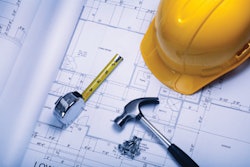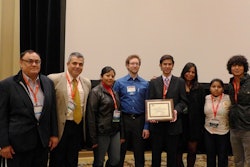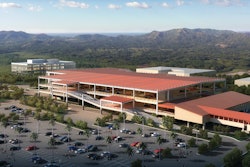A new study indicates contractors consider the green building marketplace an accelerating business opportunity, rather than a niche market. Results of the study by McGraw-Hill Construction, in partnership with United Technologies, were presented at Greenbuild International in San Francisco November 13, 2012.
Overwhelmingly, firms report that their top reasons to do green work are client demand (35 percent) and market demand (33 percent)—two key business drivers of strategic planning. The next top reasons were also oriented toward the corporate bottom line—lower operating costs (30 percent) and branding advantage (30 percent).
In contrast, the top reason in 2008 motivating the green building market was doing the right thing (42 percent) and market transformation (35 percent), followed by client and market demand.
The study also revealed that approximately 48 percent of the work by U.S. respondents was green—with that share expected to increase to 58 percent by 2015. These results are consistent with McGraw-Hill Construction’s 2013 Dodge Green Construction Outlook that sized the green building share of new construction starts in the U.S. to be 44 percent by value, and up to 55 percent by 2015.
"This research confirms that green building advances environmental stewardship while providing value to the market," said Geraud Darnis, president and CEO, United Technologies Climate, Controls & Security. "It also confirms that we now see more pull than push for green buildings."
In the next three years, the sectors with the largest opportunity for green building around the world include new construction and renovation projects. Sixty three percent of firms have green work planned in new commercial projects and 45 percent in new institutional projects by 2015, and 50 percent have plans for green renovation work.
In the United Kingdom and Singapore, green renovation projects were planned by the greatest number of firms at 65 and 69 percent respectively. In Brazil and UAE, new projects pose the largest opportunity. In Brazil, 83 percent of firms are planning to work on new green commercial projects over the next three years, and in the UAE, 73 percent have new green institutional projects planned.
"It is notable that over the next three years, firms working in countries around the world have green work planned across all building types, incorporating both new construction and renovation," said Harvey M. Bernstein, vice president at McGraw-Hill Construction. "The existing building market is a ripe opportunity for green building, and we are seeing that play out in the market. It is clear that green is becoming an important part of the future landscape of the global construction marketplace, and firms will need to be prepared for that transition."
Green buildings are also expected to garner business benefits for building owners. For new green building projects, firms report median operating cost savings of 8 percent over one year and 15 percent over five years, as well as increased building values of 7 percent (according to design and construction firms) and higher asset valuation of 5 percent (according to building owners).
For green retrofits, operating savings are higher than for new buildings with operating costs reported to decrease by 9 percent over one year and 13 percent over five years. Asset valuation is also expected to increase, though at more moderate levels than for new green buildings—design and construction professionals expect 5 percent increased building value from green retrofits, and owners expect higher asset valuation of 4 percent. For green projects, payback on efforts is expected within 8 years for new projects and 7 years for retrofit/renovation work.
Other significant findings include:
- Human factor benefits are driving green building more today compared to three years ago—55 percent cite greater health and well-being as the top social reason for green (tied with encouraging sustainable business practice), up from only 29 percent in 2008.
- Energy use reduction tops the environmental reasons for green building—72 percent say it is the important environmental reason to engage in green building.
- Water use reduction is more important today. 25 percent of study respondents cite reduced water consumption as the top reason, up from only 4 percent in 2008. It is particularly important in the UAE (64 percent cite it as a top reason), Brazil (39 percent), and the U.S. (32 percent), ranking as the second most important environmental factor in these countries.
- Improved indoor air quality is also more important today—17 percent cite it as a top reason to engage in green building, up from only 3 percent in 2008.
- For firms not currently doing any green project work, the primary driver that they think will motivate future green activity is the desire to do the right thing. This is in sharp contrast to those involved, suggesting this market is not as familiar with the business case for green building.
"We’ve been on the ground watching the markets shift to green around the world. Today, there are green building councils in 92 countries—more than double what it was when we first looked at the green building market globally in 2008," said Jane Henley, president of the World Green Building Council. "The business case is helping move the markets, and this study underscores the importance of measuring and reporting those benefits."
"This study validates what we’ve experienced the past couple of years — that the business community has fully embraced green building as a strategic business imperative that also happens to have a strong societal benefit," said Rick Fedrizzi, president, CEO and founding chair, U.S. Green Building Council. "We see this as a success of LEED and all the rating systems that have helped drive green building movement globally."
The findings are drawn from a McGraw-Hill Construction survey of firms across 62 countries around the world. Firms include architects, engineers, contractors, consultants and building owners. The sample was drawn from firm members of the World Green Building Council in 62 countries, other global industry associations, and the ENR Top Lists. Of the respondents, 92 percent are members of Green Building Councils around the world.
The results include a feature of 9 countries around the world with sufficient sample for statistical analysis. The study expands and contrasts against McGraw-Hill Construction’s 2008 Global Green SmartMarket Report study. Given the survey sample source, McGraw-Hill Construction compared the sample against a non-GBC member audience, which was comparable in terms of involvement in green and planned activity. Further, the U.S. sample was consistent with McGraw-Hill Construction’s extensive analysis of the U.S. construction market through its Dodge project data.
The study was produced in partnership with United Technologies with support from the World Green Building Council and the U.S. Green Building Council. Other research association partners include the Chartered Institute of Buildings, International Federation of Consulting Engineers (Fédération Internationale Des Ingénieurs-Conseils), Association for Consultancy and Engineering, Conseil International du Bâtiment (International Council for Building), Architect’s Council of Europe, and the Royal Institution of Chartered Surveyors. A separate survey of global manufacturing firms was also conducted.
The results of the study werer presented November 13 in San Francisco at the International Summit at the Greenbuild Conference and Expo at the Moscone Center—West Building, with remarks by Geraud Darnis, president & CEO United Technologies Climate, Controls & Security at noon pacific time and presentation by Harvey Bernstein at 4:15 p.m. pacific time. The study will also be discussed at a panel from 11:00 to 11:30 a.m. pacific time on Wednesday, Nov. 14, at the McGraw-Hill Construction Booth #3539 in the Moscone Center—North Building Exhibit Hall. The panel will feature executives from McGraw-Hill Construction, United Technologies Climate, Controls & Security, World Green Building Council and U.S. Green Building Council.
For more key findings from the 2012 World Green Buildings Study, visit http://bit.ly/ZD4zz5. The full report containing these and other study results will be published as part of McGraw-Hill Construction’s SmartMarket Report series, with global release anticipated in the first quarter of 2013.


















